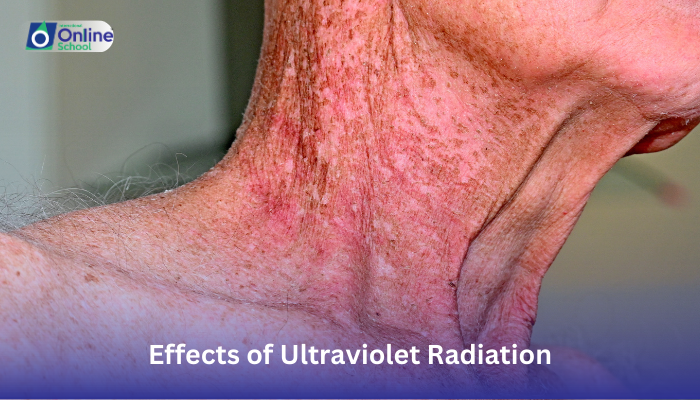
Learning Outcomes:
i. Describe the different types of ultraviolet (UV) radiation and their varying degrees of harm.
ii. Explain the short-term and long-term effects of UV radiation exposure on human health.
iii. Analyze the factors that influence UV exposure and the importance of sun safety practices.
iv. Appreciate the responsibility of individuals and communities in promoting responsible sun behavior and protecting public health.
Introduction:
Imagine a silent force, invisible yet potent, wielding a double-edged sword. This force is ultraviolet (UV) radiation, a form of energy emitted by the sun. While essential for life in small doses, its excessive exposure can have detrimental consequences for human health. Today, we delve into the hidden effects of this solar radiation, understanding its varying types, its impact on our well-being, and the crucial steps we can take to protect ourselves and our communities.
i. The Spectrum of Risk: Types of UV Radiation:
The sun emits three main types of UV radiation:
UVA: The longest wavelength, penetrating deep into the skin, causing premature aging and wrinkles. Imagine UVA rays as mischievous hands sneaking into your skin's deepest layers, leaving behind signs of time.
UVB: Shorter wavelength, responsible for sunburn, redness, and skin cancer. Imagine UVB rays like tiny darts, piercing the skin's surface and causing immediate or delayed damage.
UVC: The shortest and most damaging, fortunately filtered out by the ozone layer before reaching Earth's surface. Imagine UVC rays as microscopic spears, thankfully intercepted before they can wreak havoc on our skin and eyes.
ii. The Sun's Shadow: Short-Term and Long-Term Effects of UV Exposure:
Excessive UV exposure has both immediate and long-term consequences:
Short-term: Sunburn, skin redness, and inflammation, eye damage like cataracts, and a weakened immune system. Imagine a day at the beach ending with a burning sensation and blurry vision, a harsh reminder of overexposure.
Long-term: Premature aging, wrinkles, and increased risk of skin cancer, including melanoma, the most aggressive form. Imagine a future where sun-kissed skin becomes etched with wrinkles and shadowed by the threat of cancer.
iii. The Sun's Spotlight: Factors Influencing UV Exposure:
Several factors influence UV exposure:
Sun intensity: UV levels are highest around midday, during summer months, and at higher altitudes. Imagine the sun as a dimmer switch; its intensity varies throughout the day and year, affecting the amount of radiation we receive.
Skin type: Fairer skin is more sensitive to UV radiation than darker skin. Imagine skin as a natural sunscreen; its pigmentation determines the level of protection it offers.
Geographical location: Ozone layer thickness and cloud cover influence UV levels. Imagine the ozone layer as a protective shield; its strength and cloud cover affect the amount of UV radiation that reaches us.
iv. The Sun's Shield: Sun Safety Practices and Public Health:
Protecting ourselves from harmful UV exposure is crucial:
Seek shade and cover: Avoid direct sunlight, especially during peak hours, and wear protective clothing like hats and sunglasses. Imagine shade as a cool haven, a temporary escape from the sun's harsh rays.
Sunscreen is your superhero: Apply broad-spectrum sunscreen with SPF 30 or higher, and reapply frequently, especially after swimming or sweating. Imagine sunscreen as an invisible shield, deflecting the sun's harmful beams.
Awareness and education: Share knowledge about sun safety practices, encourage responsible sun behavior in your community, and advocate for sun protection initiatives. Imagine a community bathed in awareness, where sun safety becomes a shared responsibility.
UV radiation, though a natural component of sunlight, can be a silent threat to our health. Understanding its types, its effects, and the factors influencing exposure empowers us to take charge of our sun safety. By adopting responsible practices, educating others, and promoting awareness, we can turn the sun's hidden dagger into a reminder of our collective responsibility to protect ourselves and each other, creating a future where sunshine illuminates our lives without casting shadows on our health.